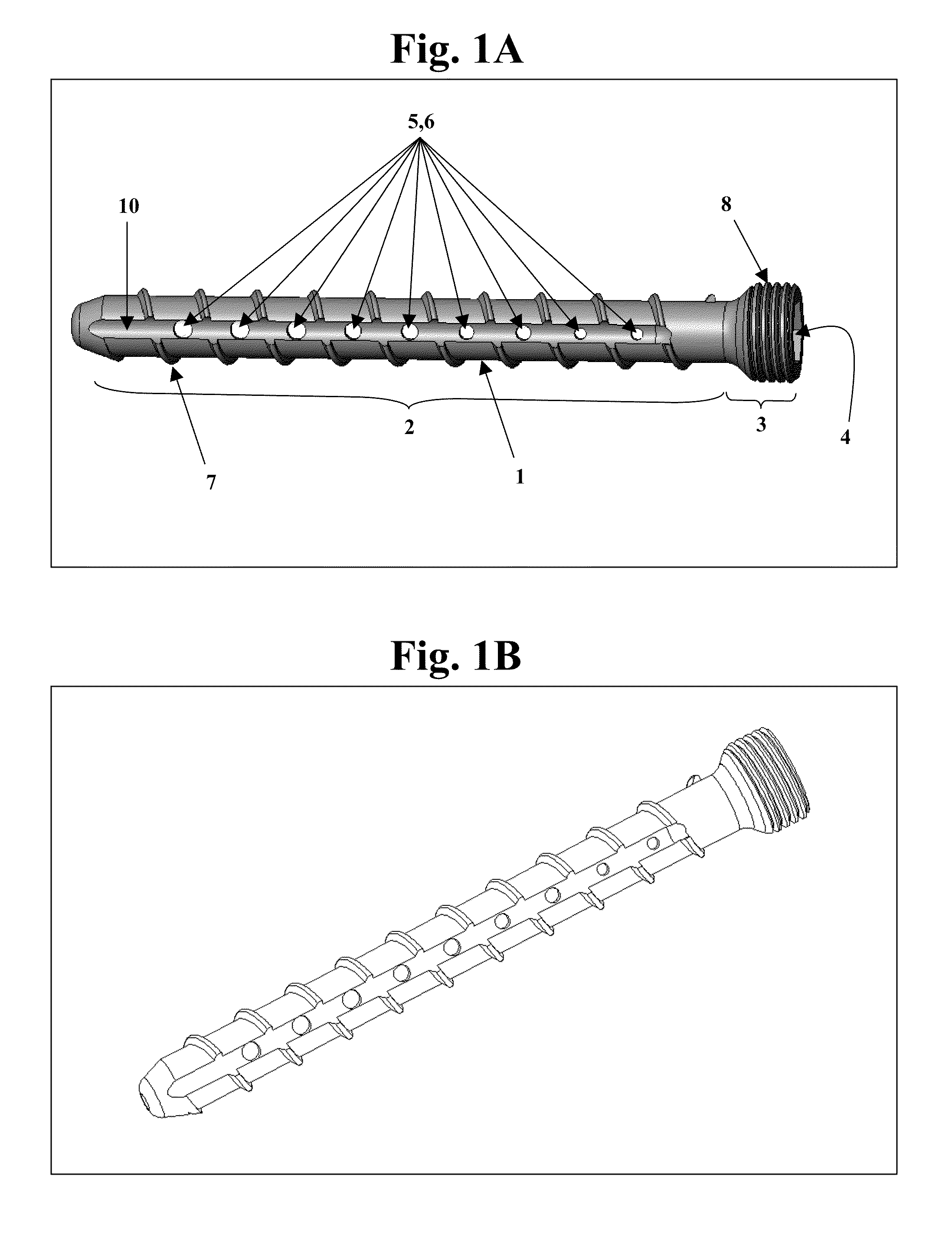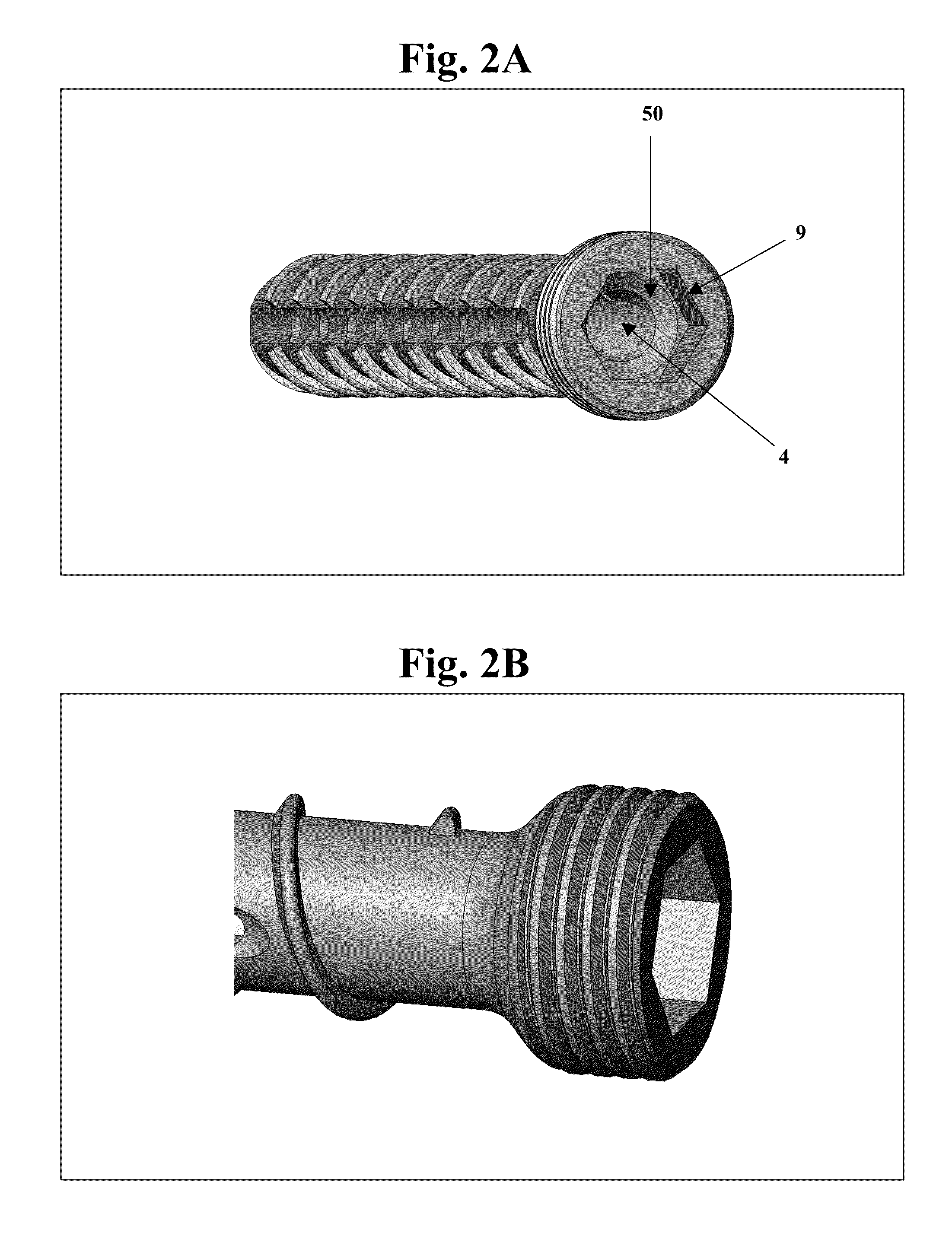Bone screws and methods of use thereof
a bone screw and screw technology, applied in the field of bone screws, can solve the problems of screw loosening, screw loosening, and bone screw backout, and achieve the effect of faster advance of bone screw and flow more easily through the delivery channel
- Summary
- Abstract
- Description
- Claims
- Application Information
AI Technical Summary
Benefits of technology
Problems solved by technology
Method used
Image
Examples
example 1
Use of a Bone Screw of the Invention to Repair a Fracture or Other Bone Defect
[0113]A bone screw of the invention can be used to provide fracture support, e.g., for a subarticular fracture, in conjunction with conventional fixation. The site to be supported can be accessed using either a percutaneous or open technique. The extraction technique preferably ensures maximal bone conservation.
[0114]Uni-Cortical and Bi-Cortical Fixation
[0115]A bone screw of the invention can be used for uni-cortical fixation to cross one of the sections of the thick cortical wall of a bone, as shown schematically in FIG. 18A. An exemplary bone screw for uni-cortical fixation is, e.g., 25-55 mm long, with, e.g., a 4.0 mm major diameter and, e.g., a 1.6 mm interior channel diameter.
[0116]Alternatively, for bi-cortical fixation, the bone screw penetrates all the way through the bone and reaches the opposite thick cortical wall, as shown schematically in FIG. 18B. An exemplary bone screw for bi-cortical fixat...
example 2
Use of a Bone Screw of the Invention to Facilitate Dental Implant
[0122]A blind hole created during tooth replacement often requires a bone graft in order to provide support for the post of a dental implant. A bone screw of the invention can be used to facilitate placement of such an implant. As shown in FIGS. 20A-20D, a bone screw optimized for dental applications contains a curved cap affixed to the screw head. For example, the bone screw can have an interior channel diameter of 1.0-2.0 mm, e.g., 1.2 mm, and a major diameter of 3.0-5.0 mm, e.g., 3.0 mm.
[0123]The bone screw is first inserted into, e.g., the maxilla or mandible, and bone cement or other flowable medium is injected and evenly distributed along the axis of the hole. The curved cap is shaped to contain the flowable medium. The cement can act to rebuild the lost bone stock, which allows for increased height of bone anchorage and permits sufficient stability for subsequent insertion of a dental implant over the bone screw...
example 3
Use of a Bone Screw of the Invention to Repair Fractures Near Joints that are Reconstructed but do not Have Enough Load-Bearing Strength with Conventional Fixation Alone
[0125]A patient presents with a fracture of the tibia or femur occurring near the tibial-femoral or tibial-talar joint. For example, in a high-speed automobile collision, the femur just above the knee can break when the crash victim's bent leg hits the dashboard. The bone may break into two, three, or more pieces. The site to be repaired can be accessed using a percutaneous or open technique. The small profile of cement connection means the screw and cement can be done with a wide incision (open) or with a very small incision (closed).
[0126]By using a bone screw of the invention, subsequent screw removal is possible while ensuring maximal bone conservation. For example, a screw designed for use with an interior rotational driver, e.g., an internal hex driver, eliminates the need to use a large external driver, e.g., ...
PUM
 Login to View More
Login to View More Abstract
Description
Claims
Application Information
 Login to View More
Login to View More - R&D
- Intellectual Property
- Life Sciences
- Materials
- Tech Scout
- Unparalleled Data Quality
- Higher Quality Content
- 60% Fewer Hallucinations
Browse by: Latest US Patents, China's latest patents, Technical Efficacy Thesaurus, Application Domain, Technology Topic, Popular Technical Reports.
© 2025 PatSnap. All rights reserved.Legal|Privacy policy|Modern Slavery Act Transparency Statement|Sitemap|About US| Contact US: help@patsnap.com



